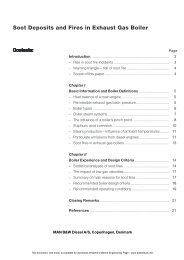Fire on Board the Liberian Passenger Ship Ecstasy, Miami, Florida ...
Fire on Board the Liberian Passenger Ship Ecstasy, Miami, Florida ...
Fire on Board the Liberian Passenger Ship Ecstasy, Miami, Florida ...
- No tags were found...
Create successful ePaper yourself
Turn your PDF publications into a flip-book with our unique Google optimized e-Paper software.
Analysis 62 Marine Accident Reportsprinkler coverage of <strong>the</strong> vessel’s mooring decks. The company also began a program ofretrofitting <strong>the</strong> mooring decks of its existing cruise ships with deluge sprinkler systems.According to Carnival Cruise Lines’ senior officials, <strong>the</strong> aim of <strong>the</strong> company is to installsprinkler protecti<strong>on</strong> <strong>on</strong> <strong>the</strong> mooring decks of all its ships by <strong>the</strong> end of 2001. The Safety<strong>Board</strong> applauds Carnival Cruise Line’s past and c<strong>on</strong>tinuing efforts to improve fire safety<strong>on</strong> <strong>the</strong> ships in its fleet.The flag administrati<strong>on</strong> for <strong>the</strong> <strong>Ecstasy</strong> before <strong>the</strong> accident had categorized <strong>the</strong>vessel’s mooring stati<strong>on</strong> as an open deck, which meant that <strong>the</strong> area was not required tohave smoke detectors or sprinklers. If <strong>the</strong> mooring stati<strong>on</strong> had been equipped withdetectors, <strong>the</strong> bridge would have received earlier notificati<strong>on</strong> of a fire site. In additi<strong>on</strong>, ifsprinklers had been installed and had activated <strong>on</strong> <strong>the</strong> mooring deck, <strong>the</strong> water may haveextinguished <strong>the</strong> ignited lint before <strong>the</strong> mooring line caught fire. At <strong>the</strong> least, water fromactivated sprinklers would have knocked down <strong>the</strong> flames of <strong>the</strong> mooring deck fire, whichprobably would have enabled shipboard firefighters to enter <strong>the</strong> mooring stati<strong>on</strong> andcombat <strong>the</strong> fire. The Safety <strong>Board</strong> c<strong>on</strong>cludes that if an automatic fire suppressi<strong>on</strong> systemhad been installed <strong>on</strong> <strong>the</strong> mooring deck, <strong>the</strong> fire <strong>on</strong> <strong>the</strong> <strong>Ecstasy</strong> would have been locatedand extinguished much so<strong>on</strong>er, <strong>the</strong>reby minimizing <strong>the</strong> extent of fire damage <strong>on</strong> <strong>the</strong> vesseland aft mooring deck.As it was, <strong>the</strong> high fuel load <strong>on</strong> <strong>the</strong> mooring deck caused extensive damage. Themooring stati<strong>on</strong> had 11 mooring lines, each measuring 220-meters and weighing about900 pounds. The line itself is not easy to ignite. Inspecti<strong>on</strong> of a sister vessel showed thatlarge amounts of easily ignitable lint had accumulated <strong>on</strong> <strong>the</strong> mooring deck and hadbecome imbedded in <strong>the</strong> stored mooring lines. Assuming that <strong>the</strong> <strong>Ecstasy</strong> had a similaraccumulati<strong>on</strong> of lint, <strong>the</strong> fire venting from <strong>the</strong> mangle exhaust plenum probably ignited<strong>the</strong> lint, which, in turn, ignited <strong>the</strong> polypropylene mooring line. The Safety <strong>Board</strong>c<strong>on</strong>tracted independent tests by Omega Point Laboratories, which determined that <strong>the</strong>polypropylene line had an average heat of combusti<strong>on</strong> of about 18,217 Btu per pound.Thus, <strong>the</strong> c<strong>on</strong>sumpti<strong>on</strong> of <strong>the</strong> polypropylene line <strong>on</strong> this deck could have yielded as muchas 150 milli<strong>on</strong> Btu of heat. Once ignited, <strong>the</strong> amount of heat released from polypropylenerope per pound is equivalent to that of a comparable amount of gasoline.The investigati<strong>on</strong> showed that <strong>the</strong> fire c<strong>on</strong>sumed most of <strong>the</strong> fuel (polypropyleneline) <strong>on</strong> <strong>the</strong> mooring deck before firefighters were able to reach <strong>the</strong> deck and extinguish it.A pallet of nyl<strong>on</strong> line survived <strong>the</strong> fire but was melted. Two lengths of polypropylene ropewere partially c<strong>on</strong>sumed and <strong>the</strong> o<strong>the</strong>rs were completely destroyed.In <strong>the</strong> past, cruise ships typically were designed with mooring decks having ei<strong>the</strong>rno overhead or an overhead and large permanent openings in <strong>the</strong> vessel’s side shell.Because <strong>the</strong> mooring deck area was open to <strong>the</strong> wea<strong>the</strong>r elements, <strong>the</strong> risk of fire was low;<strong>the</strong>refore, SOLAS did not require mooring decks to have fire protecti<strong>on</strong>. Modern cruiseship design, such as that of <strong>the</strong> Fantasy Class vessels, typically incorporates <strong>the</strong> mooringstati<strong>on</strong> into <strong>the</strong> superstructure, often below accommodati<strong>on</strong> and service spaces. Manymooring stati<strong>on</strong>s have openings that can be closed with hatches or covers. Despite this lossof openness, SOLAS still categorizes <strong>the</strong>se mooring stati<strong>on</strong>s as open decks that are notrequired to have fire protecti<strong>on</strong> systems. Some newer ship designs also place ventilati<strong>on</strong>
















